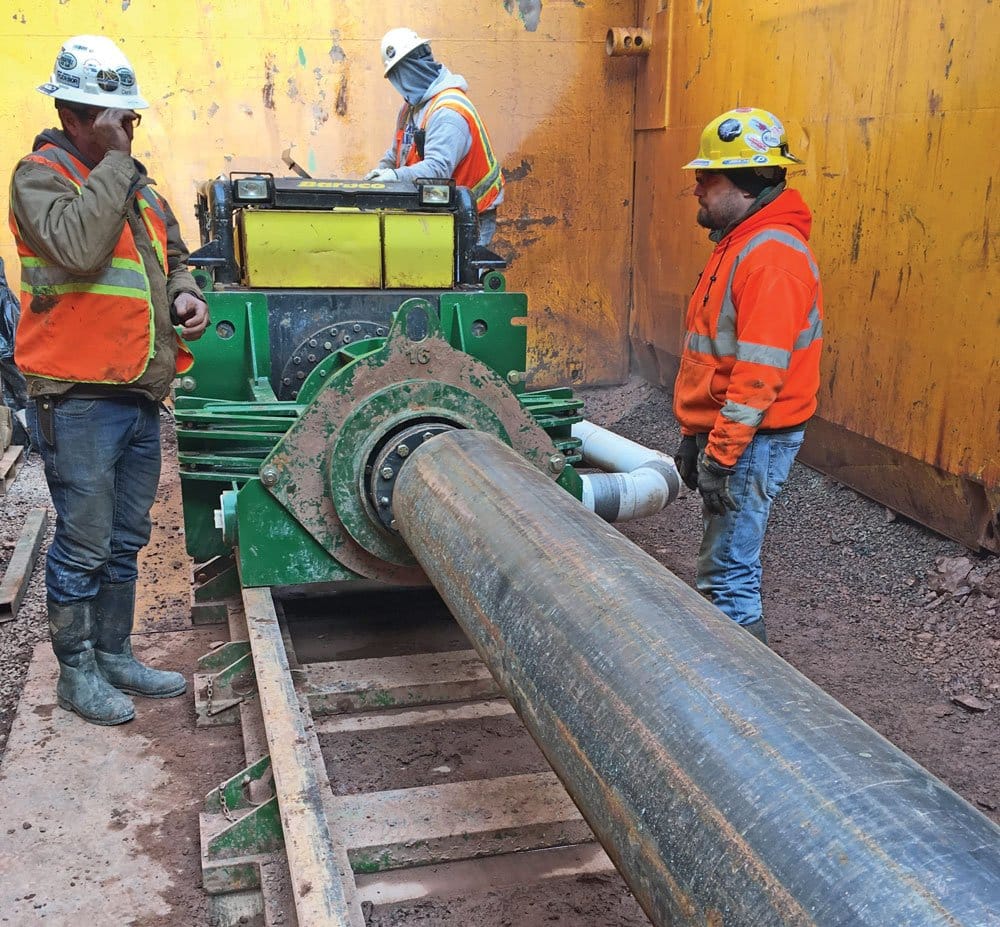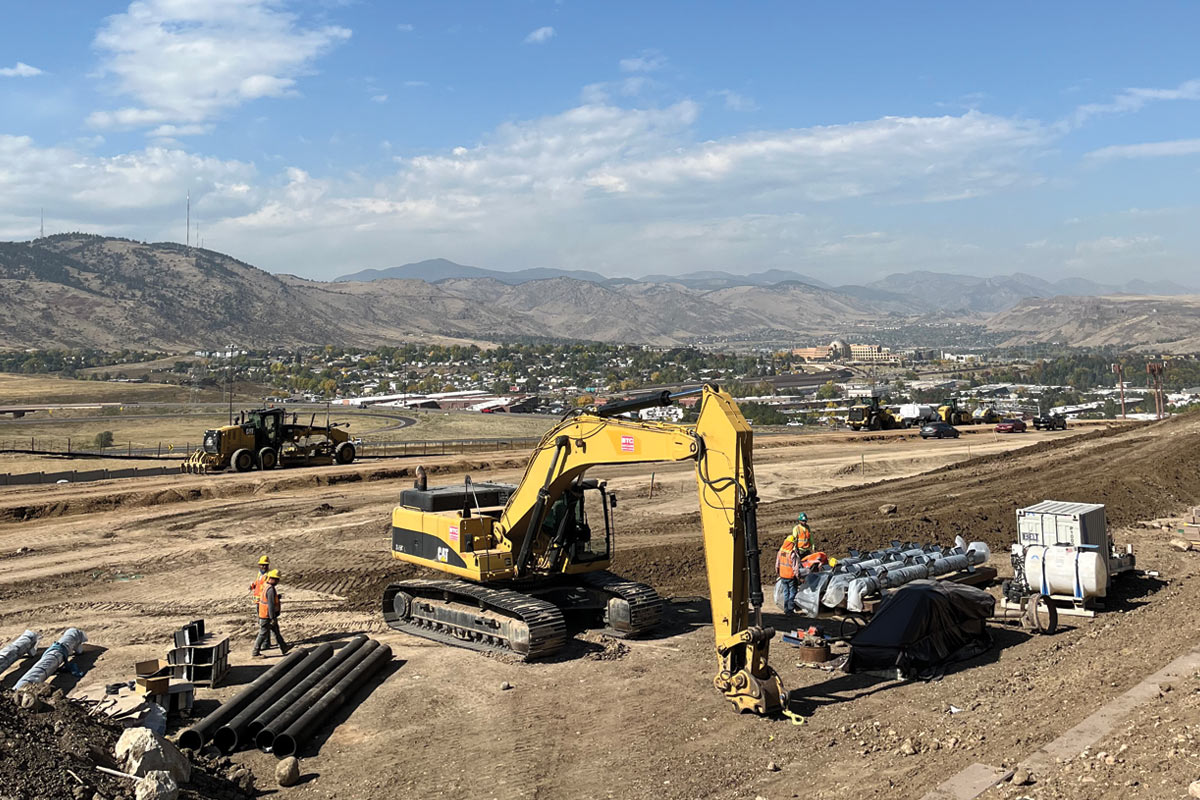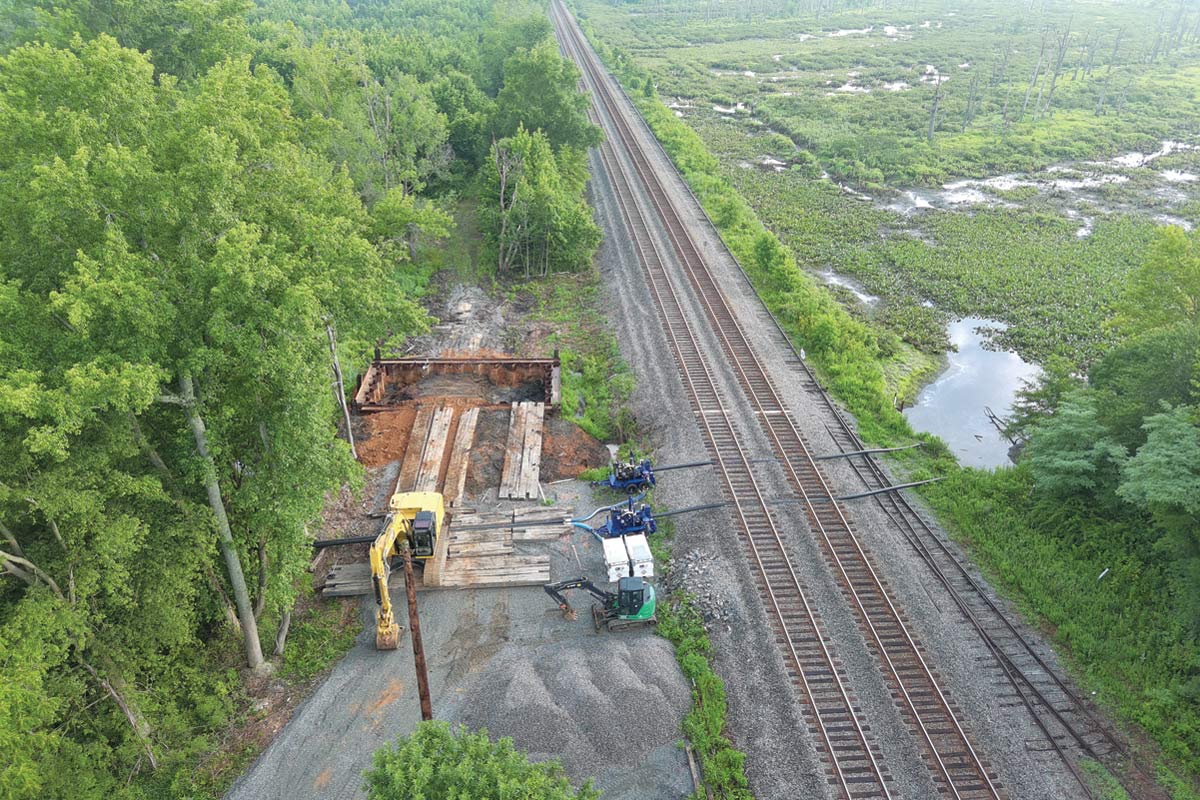
Auger Boring Market Remains Strong, Continues to Evolve
Despite Being One of the Oldest Trenchless Technologies, the Auger Boring Market Remains Strong and Continues to Evolve
When it comes to the installation of underground utilities with minimal surface disruption, auger boring has a long track record of success. In fact, auger boring was a proven trenchless method before the term “trenchless” even entered the lexicon.
The process of auger boring involves excavating the face of the tunneling, using flighted augers to carry the spoil back to the launch pit, while simultaneously jacking in casing pipe to support the excavation. Typically, auger boring is used for installing pipes under railways or roads where settlement or upheaval is a concern. Auger boring can used for projects up to about 60 in. and lengths of up to about 600 ft.
Historically, auger boring machines were technically non-steered, but recent advancements have allowed contractors more ability to keep the machine on line and grade. While auger boring may be the oldest of trenchless technology, the auger boring market doesn’t stand still. Technology advances and new applications are constantly expanding the market.
To get an understanding of the auger boring market, how it is changing and where it is heading, we talked to three of the leading manufacturers of auger boring equipment: Akkerman Inc., Brownsdale, Minnesota; Barbco Inc., East Canton, Ohio; and Michael Byrne Mfg. Co. Inc., Mansifeld, Ohio. Providing responses were Jason Holden of Akkerman; Dave Barbera, Tony Barbera and Scott Fisher of Barbco; and Jim Weist of Michael Byrne.
How would you rate the current auger boring and tunneling market?
Akkerman – The auger boring market remains strong with some contractors reporting several months of work backlog. The number of auger boring projects that have been put out for public bidding has increased by nearly 10 percent in the first quarter of 2018 compared to the same timeframe in 2017.
The tunneling market is not as geographically consistent as with auger boring, however it can still be considered strong for many in the industry. As policies unfold with Trump’s infrastructure plan, it may become more of the new norm to see shining star regions in the industry as cities and states gravitate toward public-private partnership (PPP) model programs.
Barbco – Barbco views the current auger boring market as very strong. It being one of the oldest modes of trenchless technology, auger boring has only gotten more advanced both in accuracy and efficiency. Safety features and standards have also progressed, greatly making it more appealing to potential auger boring professionals and keep current professionals safe.
Michael Byrne Mfg. – The market is strong – some of this related to the HDD machine problems with frac-outs and the bad press associated with that recently. The cost-effectiveness for the auger boring method compared to other methods for short to medium length bores is still significant.
RELATED: Auger Boring: A Key Component in Railroad Expansion
 Which segments of the industry has the most influence on the market? What are potential areas of growth?
Which segments of the industry has the most influence on the market? What are potential areas of growth?
Akkerman – Currently oil and gas are driving much of the auger boring industry. This situation is expected to remain unchanged well into 2019. Gas distribution is currently the highest performing utility market and is driving demands. However, this trend is going to slowly evaporate in the next four to five years unless users experience rate increases.
Water and sewer have been the lowest-performing utility market since nearly 2012, but capital spending has been increasing. Trump’s infrastructure plan to support water and sewer infrastructure is proposed to incorporate a PPP model. This infrastructure plan will require the matching funds from the state level, which will normalize user rates. For states that are in good fiscal health, this funding model will prove very successful and create a bullish tunneling market for those specific regions.
Barbco – Although all of these market sectors have big impressions on the industry, we believe the oil and gas market to be the No. 1 industry segment due to our nation’s pursuit of energy independence. An area we feel is already huge and has immense growth potential is in new and rehabilitating infrastructure due to many smaller or under developed countries continuing to modernize and updating of existing infrastructures.
Michael Byrne Mfg. – The oil and gas market have been very strong recently with all the pipeline/energy work that is going on around the country. The water and sewer markets have continued to remain consistent and we anticipate an uptick in this over the next several years if we can get an infrastructure bill in place.
Auger boring has been around for a number of years but it continues to evolve. How has the technology changed over the years? What advances have had the most impact on the market?
Akkerman – The auger boring industry seems to take monumental strides on a yearly basis. Akkerman has been producing Guided Boring System (GBM) to provide straight and accurate alignments for nearly two decades. Early guided boring equipment worked in limited ground conditions with restricted lengths. Advances in technology have allowed contractors to install pilot tubes in a much wider range of ground conditions including rock with distances exceeding 500 lf.
With the ability for longer pilot tube installations, auger boring manufacturers have also increased power and performance requirements, allowing contractors to go bigger, further and faster.
I also should note that one of the best evolutions in the auger boring industry is Jim Wiest’s, “Make Boring Great Again” T-shirt from Michel Byrne Mfg. It’s become iconic!
Barbco – The auger boring industry has come a long way in many aspects; remote controlled equipment, environmentally sensitive tooling and other advances have brought the industry a long way. We at Barbco feel that the biggest advancement that has been made in this field has been the integration of guided boring. This innovation has not only led to higher accuracy in the field but also higher efficiency and an overall safer bore.
Michael Byrne Mfg. – The advent of guided boring systems and guided auxiliary components has been a technology that continues to be evolving into a more sizeable portion of the auger boring methodology. Larger and longer bores are also becoming more common in recent years. Cutting tool technology has also progressed to give a longer wear, and more aggressive cutting for harder rock.
How do equipment manufacturers develop new technology? How can contractors play a role in equipment development?
Akkerman – It is crucial to develop new technology with the interest of the customer in mind. The learning curve in the trenchless industry is more like an endless loop. It would be foolish to not fully understand both the good and the bad experiences from customers and learn from them. We value the input from our customers and use this information to ensure that our products are ever evolving toward providing the best solutions in the trenchless market.
RELATED: Auger Boring in Arizona Helps to Install Water Line
Barbco – One of the biggest ways we develop new technology is by listening to and actively working with our customers. The field experience they have allows them to know better than most what is needed to get the job done effectively. Technology trade shows for engineers and manufacturers are another way we acquire industry knowledge to incorporate in our processing methods and equipment design.

What about safety advances — What improvements have you seen? Do you ever see examples of older machines that perhaps do not measure up to newer safety standards? Is there a way to upgrade older machines to achieve a similar level of safety?
Akkerman – Safety should always be at the top of everyone’s priority list. Owners, engineers, contractors, manufacturers and employees must become accountable for safety. One of the biggest improvements in the industry is the acceptance of necessary training and the organizations, such as NUCA, that promote safety programs.
On the equipment side, it is great to see the features such as remote control, rollover protection, gas monitoring and electronic fail-safes. Most manufacturers will figure out a price to upgrade your equipment or sell you a new one … trust me!
Barbco – In regards to safety standards, there are a wide range of features on newer machines, from rollover anticipation to remote control options and many others, to ensure a safer boring process and overall jobsite. In regards to older equipment, fortunately in most cases, they can be updated at the manufacturer’s facility.
Michael Byrne Mfg. – We have integrated sensors to shut down machines if they tilt out of their axis to help prevent rollovers. The new engines provide a cleaner environment in the pit for operators and laborers. Michael Byrne Mfg. machines meet the CE safety standards and are CE approved.
Are there general guidelines for grade and accuracy that can be achieved by auger boring? Is there an issue with overly high (or low) expectations of what the machines can realistically achieve? What are some common misconceptions you see?
Akkerman – The Guided Auger Boring (GAB) method has significantly improved the accuracy of a conventional jack-and-bore installation. Although even I find myself correcting overzealous engineers of high expectations for the accuracy of GAB, the results from a careful pilot tube installation set-up are remarkably accurate. The overall accuracy is dependent on several factors, such as the subsurface conditions, set-up and transfer of survey points for the guidance system, equipment set-up, drive length, and air quality inside the pilot tube.
One of the biggest misconceptions is the lack of proper planning on the set up. As with any trenchless project, proper planning is the key to success!
Barbco – With so many obstacles to look after in any boring job, guidelines for grade and accuracy are very high, many times to the point where contractors will call for a microtunneling machine vs. an auger boring machine in these precise jobs. The misconception lies in the thinking that the auger boring machine cannot meet these guidelines and standards. Equipped with guided boring technology and a well-rounded operator, auger boring jobs can be very accurate and also more economical.
Michael Byrne Mfg. – Michael Byrne Mfg. has designed a swivel type cutting head to follow the guided bore system pilots as well as directional drills to open bores to the finished size desired, we have had positive results with this with several contractors.
What current challenges are you facing as a manufacturer?
Akkerman – Equipment manufacturers face the same challenges as our contractors. As the trenchless industry advances and companies seek to grow larger, acquiring new and skilled labor talent is a serious investment.
Lead times of purchase components for equipment builds have increased significantly due to a surge in demand from other markets. Many vendors and suppliers of these components maintain a LEAN stocking principle, which puts pressure on the manufacturers to carry excessive inventory to meet the tight deadlines of the construction industry.
There are several challenges that all businesses such as Akkerman face on a weekly basis but with strong leaders, dedicated employees and hard work we keep moving forward so that we can do our part in working toward the light at the end of the tunnel.
RELATED: Auger Boring in Virginia: Crews Are Installing Two Bores for a New Water Line
Barbco – The most difficult obstacles that we at Barbco run into as a manufacturer are material cost and availability due to restrictions and tensions on the issue of importation of materials such as steel or iron ore causing volatility in the steel market. The other issue of a similar degree would be acquiring skilled labor to keep up with today’s ever-changing manufacturing scene. As machinery becomes more and more advanced, employees are now required to have some higher forms of education in order to be able to handle new equipment and manufacturing processes.
Michael Byrne Mfg. – The issue of finding new workers to replace existing workers is the challenge that almost every industry is facing in today’s environment, the need for trades education is at a critical point. I know some contractors must hire foreign workers to work many of their jobs because the source is dried up for supply required.
This article first appeared in our sister publication, Utility Contractor.





